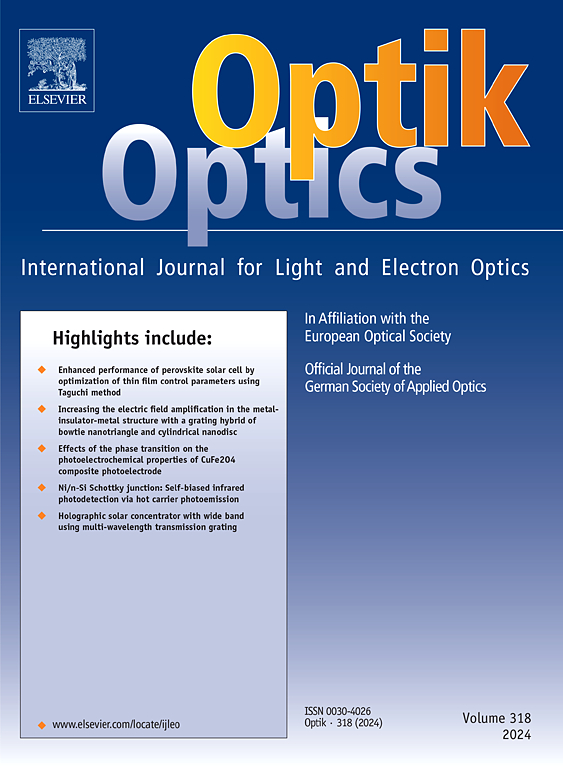基于哈尔沃森混沌系统的战斗机隐形技术微波吸收器建模
IF 3.1
3区 物理与天体物理
Q2 Engineering
引用次数: 0
摘要
本研究的重点是开发和详细分析利用哈尔沃森混沌动力学的宽带微波吸收器,以增强战斗机的隐形能力。研究首先探索哈尔沃森混沌系统的数学公式,并对其控制参数进行参数扫描,以生成不同的二维和三维混沌吸引子图。然后利用朱莉娅集理论对这些图进行后处理,形成错综复杂的分形图案,作为吸收器设计的基础。图像处理技术包括滤波和阈值处理,通过去除伪影和噪音来完善图案,确保图案适合实际应用。然后,将细化的分形图案导入计算电磁仿真环境,并将其图案化到 0.035 毫米厚的铜片上。此外,我们还选择了厚度为 1.52 毫米的 Magtrex 555 衬底,因为它具有高介电常数和低损耗特性。我们进行了一系列全面的参数研究,以评估边长、单胞几何形状和衬底厚度等各种设计参数对吸收器电磁性能的影响。重要参数包括混沌控制参数优化的效果和模拟过程中应用的电磁边界条件。在 2-20 GHz 频率范围内进行了大量仿真,以评估吸收效率,重点关注吸收率、表面电流分布和电场分布等关键指标。在对混沌控制参数进行优化后,最终设计在目标频段内实现了超过 90% 的吸收效率。最后,使用不同市售基底(包括 FR-4 和罗杰斯 RO3003)进行的比较分析表明,Magtrex 555 具有更出色的吸收性能。研究最后详细介绍了最终的吸收器设计,并深入讨论了频率范围、参数变化以及混沌系统动力学对吸收特性的影响。这项研究为基于混沌系统的微波吸收器的设计和优化提供了重要见解,推动了军事应用中隐形技术的发展。本文章由计算机程序翻译,如有差异,请以英文原文为准。
Halvorsen chaotic system based microwave absorber modelling for fighter jet stealth technologies
This study focuses on the development and detailed analysis of a broadband microwave absorber utilizing Halvorsen chaotic dynamics, that focuses at enhancing stealth capabilities for fighter jets. The investigation begins by exploring the mathematical formulation of the Halvorsen chaotic system and conducting a parametric sweep of its control parameters to generate distinct two-dimensional and three-dimensional chaotic attractor plots. These plots are then post-processed using Julia set theory to develop intricate fractal patterns, which serve as the foundation for the absorber design. Image processing techniques, including filtering and thresholding, are employed to refine the patterns by removing artifacts and noise, ensuring they are suitable for practical implementation. The refined fractal patterns are then imported into a computational electromagnetic simulation environment where they are patterned onto a 0.035 mm thick copper sheet. Moreover, the Magtrex 555 substrate with a thickness of 1.52 mm, is selected for its high permittivity and low-loss characteristics. A comprehensive series of parametric studies are conducted to evaluate the influence of various design parameters such as side length, unit cell geometry, and substrate thickness on the absorber’s electromagnetic performance. Important parameters include the effects of chaotic control parameter optimization and the electromagnetic boundary conditions applied during the simulations. Extensive simulations are performed across the 2–20 GHz frequency range to evaluate absorption efficiency, focusing on key metrics like absorptivity, surface current distribution, and electric field distribution. The final design achieves over 90 % absorption efficiency within the target frequency band when the chaotic control parameters are optimized. Finally, comparative analysis using different commercially available substrates, including FR-4 and Rogers RO3003, reveals that Magtrex 555 offers superior absorption performance. The study concludes with a detailed presentation of the final absorber design, alongside an indepth discussion of the frequency range, parametric variations, and the impact of chaotic system dynamics on the absorption properties. This research provides crucial insights into the design and optimization of chaotic-system-based microwave absorbers, that advances the development of stealth technology in military applications.
求助全文
通过发布文献求助,成功后即可免费获取论文全文。
去求助
来源期刊

Optik
物理-光学
CiteScore
6.90
自引率
12.90%
发文量
1471
审稿时长
46 days
期刊介绍:
Optik publishes articles on all subjects related to light and electron optics and offers a survey on the state of research and technical development within the following fields:
Optics:
-Optics design, geometrical and beam optics, wave optics-
Optical and micro-optical components, diffractive optics, devices and systems-
Photoelectric and optoelectronic devices-
Optical properties of materials, nonlinear optics, wave propagation and transmission in homogeneous and inhomogeneous materials-
Information optics, image formation and processing, holographic techniques, microscopes and spectrometer techniques, and image analysis-
Optical testing and measuring techniques-
Optical communication and computing-
Physiological optics-
As well as other related topics.
 求助内容:
求助内容: 应助结果提醒方式:
应助结果提醒方式:


